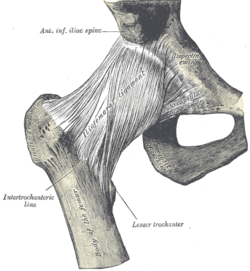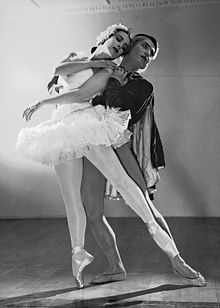Turnout (ballet)

In ballet, turnout (also turn-out) is a rotation of the leg which comes from the hips, causing the knee and foot to turn outward, away from the center of the body. This rotation allows for greater extension of the leg, especially when raising it to the side and rear.[1] Turnout is essential to classical ballet technique and is the basis on which all ballet movement follows.[2]
Range and nature of turnout
Turnout is measured in degrees with the perfect turnout measured at 180°. The angle measured is that between the feet when the heels are touching in first position. Perfect turnout is rarely attainable at the first attempt.[3]

If the turnout does not happen at the hip (which tenses this ligament) it would instead occur via lateral rotation in the knee joint. When this happens, the knee still faces forward and it is not as aesthetically pleasing and can cause future knee injury.
Some dancers will use an anterior pelvic tilt (shortening the hip flexors) because hip flexion reduces the tension on the ligament and allows lateral hip rotation to occur more easily. This will however, affect the dancer's posture, since it requires the back to hyper-extend to remain upright.
The extent to which an individual can rotate their legs is largely predetermined.[4] The degree of turnout attainable is determined by the shape of the femoral neck and the angle at which the femoral head is inserted into the hip socket, the orientation of the hip socket, the elasticity of the iliofemoral ligament, and the flexibility of the hip and thigh muscles.[5] However, the structure of the bone may be influenced by ballet exercises before a certain period of bone development attained around the age of eleven.[4]
The action of turning out the leg is more important to ballet movement than the angle that is attained. Even while standing, turnout must be maintained through an active rotation with the muscles that extends from the hip to the foot.
Developing turnout
Forcing turnout in the feet will distort the position of the entire body and often results in injury, especially to the knee. An angle of 100° will work the muscles in the hip and thigh without causing the knees to rotate inwards (and the ankles to "roll over").[3] There are also exercises which can help to improve turnout.
See also
- Health risks of professional dance
References
Sources
- Grieg, Valerie (1994). Inside Ballet Technique: separating anatomical fact from fiction in the ballet class. Hightstown, NJ: Princeton Book Publishers, Company. ISBN 0-87127-191-5.
- Kirstein, Lincoln; Stuart, Muriel (1952). The Classic Ballet. New York: Alfred A Knopf.
| ||||||||||||||||||||||||||||||||||||
